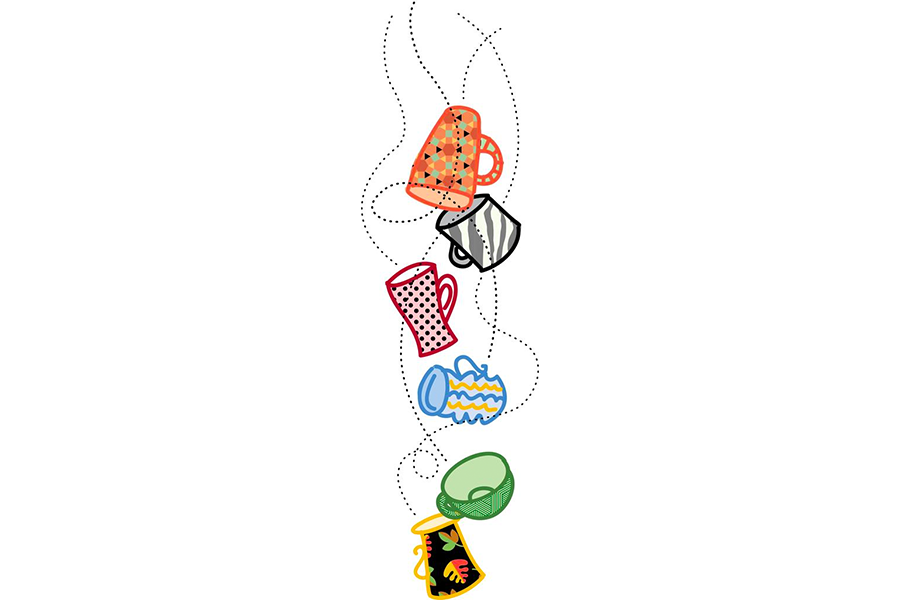My cupboard runneth over
Loading...
The day my kitchen cabinet tried to kill me began like any other day. I had just padded downstairs in my robe to start a pot of coffee when I heard an ominous creak. Then an angry roar. Then, as some previously untapped instinct kicked in and I backed across the kitchen – I was still semi-asleep – the cabinet door right above my coffeemaker opened, and my entire collection of mugs spilled out. Some dropped into the sink; the rest poured forth in an impressive flood onto my tiled floor. They landed with a crash of glass and pottery, inches from my slipper-clad feet.
It is always disturbing when one’s cabinetry turns violent. Fortunately, the explanation was simple: The plastic pegs holding up the adjustable shelves had suddenly failed, shearing off flush with the inside of the cabinet and allowing the shelves to fall. When I went to buy replacements, the hardware store guy said he’d heard my story before. Apparently, some plastic pegs weaken over time and need to be replaced every decade or so, lest they suddenly decide they’re fed up and retire in a spectacular fashion. I purchased heavy-duty metal replacements for every plastic shelf peg in the house.
That evening, as I installed the new pegs, I reflected that I’d learned a valuable lesson fairly cheaply. No one had been hurt, and I hadn’t really lost much – all my plates and cooking equipment had been in other cabinets.
But every coffee mug I owned, except for one small teacup that had been in my dishwasher, was lost. What was I to do?
I needn’t have worried. Coffee mugs, it turns out, are something of which everyone has extras. They are the opposite of socks. Instead of mysteriously disappearing, they tend to mysteriously appear, collecting in kitchens like so many ceramic dust bunnies. Regretted impulse purchases, sole survivors of long-broken dish sets, old gag gifts that had gagged far more than they’d gifted: My friends had them all. So did their friends, and their friends’ friends. And every one of them was more than willing to share their extra mugs with me.
In no time, my newly repaired cupboard ranneth over, filled with mugs of every size and shape. I was certainly grateful for the donated mugs, but some of them were radically different from what I would have chosen for myself. So here was the strange and unexpected thing: I fell in love with them. All of them.
The mug is such an attractive canvas for expression. If you can think it, it can probably be put on a mug – and most likely already has been. Our noblest dreams (“Visualize World Peace”) and our snarkiest sentiments (“I’d love to stay and chat, but I’m lying”) – they’re all right there, with full-color art or in block-print letters. My once boring cupboard was transformed into a rainbow of human experience. I quickly came to enjoy dipping into that spectrum every morning.
I also discovered that there is something uniquely satisfying about drinking from a secondhand mug. The dishwasher-faded graphics and spoon-scratched interiors are comforting, like a well-worn T-shirt: something one can relax into and simply be with, an old friend. And since much of my collection came from people I don’t know, the cups contain kernels of mystery: Who had visited Colfax, Wash., home of “The World’s Largest Chainsaw Sculpture”? Whose donation had earned them a thank-you mug from the State Historical Society of Missouri? And who had needed the comfort of a mug featuring two bedraggled kittens in the rain with the words, “I promise, someday we’ll both look back on this and laugh”? Could he or she have known that one day, that very mug would comfort me?
I don’t know. But I do know this: If you ever come by my house for coffee, you won’t find it served in a neat new cup with a matching saucer. Instead, you’ll get a unique example of human creativity that has been very much loved in the past – and will be for years to come.







